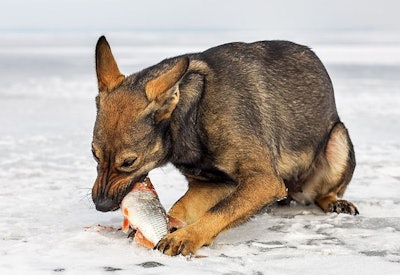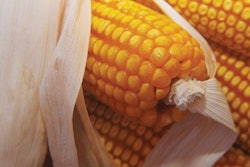
Human food trends arose from people’s intentions to eat as our Paleolithic, or Stone Age, ancestors did, and these trends transferred to pet food. The various incarnations of paleo diets focus on foods that could have been obtained through hunting and gathering, as opposed to the fruits of the farm, according to the Mayo Clinic. For dogs, the paleo diet may mean meat and other ingredients encountered around human camps. Although “discarded loincloth” will never become a dog food variety, other ancient flavors may remain to be revived as dog foods.
Popular images of prehistory involve grunting cavemen spearing a mastodon held at bay by slathering jawed wolf-dogs. However, beachside clambakes may have allowed our direct ancestors to survive humanity’s closest brush with extinction. After that, humans brought their taste for aquatic animals with them as they expanded out of Africa. During domestication proto-puppies may have dined on seafood scraps, meeting their need for fatty acids and other nutrients. Various nutritious, sustainably harvested aquatic animals, from green-lipped mussels to Asian carp, already appear in pet foods. Dog foods marketed as paleo diet, ancestral, biologically appropriate raw foods (BARF) or based on what dog’s ancestors ate could make use of these ingredients. What’s more, sustainably harvested aquatic resources often also provide health benefits from omega-3 and -6 fatty acids and other nutrients.
Seafood in human and wolf diets
Between 195,000 and 123,000 years ago, not long after humans emerged as a distinct species, an ice age caused Africa’s climate to dry and cool. As Tanzania became more like Mongolia, humans nearly died out. Biologists call this a genetic bottleneck. All our Homo sapiens ancestors descended from this small population that survived there along the coast, shucking oysters, reported Scientific American. At Pinnacle Point in South Africa, archaeologists found evidence that these surviving humans used marine resources, such as shellfish in tidal pools or beached whales. Even after humans survived their closest brush with oblivion, they continued using marine and freshwater foods and other resources. Along the coast of the Red Sea, humans cooked seafood 125,000 years ago. To the north, Neanderthals also dined on cooked shellfish 110,000 years ago.
Beyond feeding human survival, seafood may have spurred the very existence of humanity. Among archeologists, the shore-based hypothesis of human brain evolution suggests that proto-humans gained sustained access to freshwater and marine food, which helped meet the nutritional and energetic constraints of our gigantic brains.
Wolves too have found coastal regions to be rich hunting and scavenging grounds, according to the Raincoast Conservation Foundation. In the Great Bear Rainforest of North America’s Pacific Coast, wolves have adapted to eat the sea’s steady supply of seals, salmon, stranded whales and smaller creatures. These sea wolves prove far less viscous than the similarly named, sadistic Jack London character. Coastal wolves organize themselves in conventional family units, like other grey wolves, but they tend to be smaller and lighter colored. Their territories now include mostly just the sea islands and a stretch of coast in British Columbia, but these coastal wolves are all that remain from a group that once ranged from Alaska to the continental United States, according to the Journal of Mammology.
No one can prove it, but it probably took some smarts for those wolves to survive, and fish is brain food. Beyond my wild conjecture that dogs ate seafood scraps during their domestication, and that this justifies a sea wolf themed dog food, freshwater and marine resources have nutritional benefits. These nutritional aspects may help pet food companies meet pet owners’ growing demand for health and wellness pet foods.


















